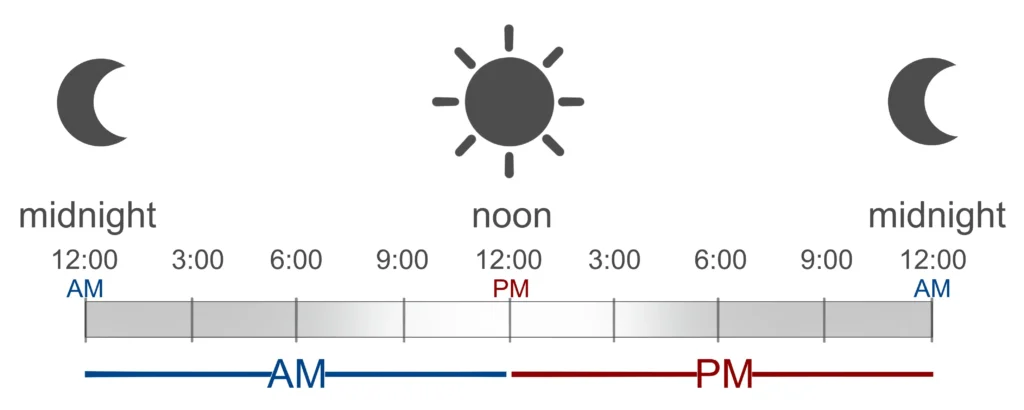AM PM FULL FORM: Origin, Uses, Time Zones around the world
We encounter many terms and abbreviations daily. “AM” and “PM” are common examples. In This article, we will talk about AM PM full form, its uses, and its significance around the world.
Read Other Full Forms
What Does AM PM Stand For?
AM and PM are abbreviations for two Latin terms, which are Ante Meridiem and Post Meridiem, respectively. They are used to indicate the time of day, either before noon (AM) or afternoon (PM). So, AM stands for “before noon,” while PM stands for “afternoon.”

The Origin of AM PM
The ancient Romans used a 12-hour clock to divide the day into AM and PM. The Egyptians and Greeks used the system for religious purposes. The 12-hour clock was widely used in Europe in the Middle Ages and eventually became the global standard for timekeeping.
AM PM Usage
AM and PM indicate morning and afternoon/evening. AM is midnight to noon, and PM is noon to midnight. The terms indicate morning or afternoon/evening events.
AM PM and Time Zones
AM/PM time zones can be confusing. London is 3:00 PM if New York is 10:00 AM. Thus, when scheduling a meeting with someone in another time zone, you must specify the time in the relevant time zone rather than just saying “10:00 AM” or “3:00 PM”.
AM PM and Work Schedules
AM PM is also used to indicate work schedules. For example, if you work a typical 9-to-5 job, you would be working from 9:00 AM to 5:00 PM. Similarly, if you work a night shift, you would be working from 10:00 PM to 6:00 AM.
AM PM and Business Operations
In the business world, AM PM is used to indicate the opening and closing hours of a business. For example, if a store is open from 9:00 AM to 6:00 PM, it means that the store is open from 9:00 in the morning until 6:00 in the evening.
AM PM in Other Languages
While AM and PM are used widely in English-speaking countries, other languages have their own terms for morning and afternoon/evening hours. For example, in Spanish, “AM” is “de la mañana,” and “PM” is “de la tarde.” In French, “AM” is “du matin,” and “PM” is “du soir.”
AM PM and Digital Clocks
In the digital age, many people rely on digital clocks and watches to tell time. In these devices, AM and PM are often represented by small letters next to the numbers, such as “10:00 am” or “3:00 pm”. Some digital clocks may also use a 24-hour format, which eliminates the need for AM PM altogether.
AM PM vs 24-hour Clocks
The US and other English-speaking countries use AM PM, but many other countries use a 24-hour clock. This system is called “military time” or “continental time.” A 24-hour clock displays time as a four-digit number with the first two digits representing the hour and the last two digits representing the minutes.
Common Confusions with AM PM
Despite its widespread use, AM PM can still be confusing, especially for people who are new to the English language or are not familiar with the 12-hour clock system. One common confusion is the use of “midnight” and “noon”. Technically, midnight is 12:00 AM, and noon is 12:00 PM. However, some people may use “12:00 midnight” or “12:00 noon” to avoid confusion.
AM PM in Different Countries
AM PM is widely used in English-speaking countries, but other parts of the world have their own ways of indicating the time of day. In some countries, such as Japan and Korea, the 24-hour clock is the standard format. In other countries, such as China and Taiwan, the 12-hour clock is used, but with different terms for AM and PM. For example, in China, “AM” is “上午” (shàngwǔ), and “PM” is “下午” (xiàwǔ).
Conclusion
AM PM helps us distinguish morning from afternoon/evening. AM PM helps us stay on track by scheduling meetings, setting alarms, and checking business hours. Understanding its origins and usage helps us appreciate and use it better.
Frequently Asked Questions
Q.1 What is the difference between AM and PM?
AM stands for “before noon,” while PM stands for “afternoon.” They are used to indicate the time of day, either before or after noon.
Q.2 Why do we use AM and PM?
AM and PM help us to distinguish between morning and afternoon/evening hours, and they are used widely in English-speaking countries.
Q.3 What is the 24-hour clock?
The 24-hour clock is a timekeeping system that eliminates the need for AM and PM. The time is indicated as a four-digit number, with the first two digits representing the hour and the last two digits representing the minutes.
Q.4 Can I use “12:00 midnight” or “12:00 noon”?
Technically, midnight is 12:00 AM, and noon is 12:00 PM. However, some people may use “12:00 midnight” or “12:00 noon” to avoid confusion.
Q.5 How is AM PM used in other languages?
Other languages have their own terms for morning and afternoon/evening hours. For example, in Spanish, “AM” is “de la mañana,” and “PM” is “de la tarde.” In French, “AM” is “du matin,” and “PM” is “du soir.”

